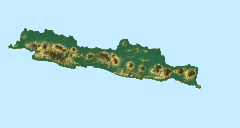
Proboscidea is a taxonomic order of afrotherian mammals containing one living family (Elephantidae) and several extinct families. First described by J. Illiger in 1811, it encompasses the elephants and their close relatives. From the mid-Miocene onwards, most proboscideans were very large. The largest land mammal of all time may have been a proboscidean; Palaeoloxodon namadicus was up to 5.2 m (17.1 ft) at the shoulder and may have weighed up to 22 t, almost double the weight of some sauropods like Diplodocus carnegii. The largest extant proboscidean is the African bush elephant, with a record of size of 4 m (13.1 ft) at the shoulder and 10.4 t. In addition to their enormous size, later proboscideans are distinguished by tusks and long, muscular trunks, which were less developed or absent in early proboscideans.
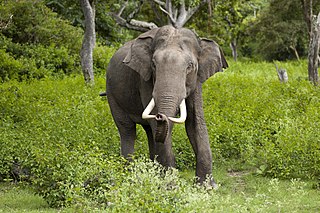
Elephantidae is a family of large, herbivorous proboscidean mammals collectively called elephants and mammoths. These are large terrestrial mammals with a snout modified into a trunk and teeth modified into tusks. Most genera and species in the family are extinct. Only two genera, Loxodonta and Elephas, are living.
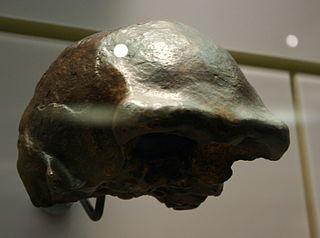
Solo Man is a subspecies of H. erectus that lived along the Solo River in Java, Indonesia, about 117,000 to 108,000 years ago in the Late Pleistocene. This population is the last known record of the species. It is known from 14 skullcaps, two tibiae, and a piece of the pelvis excavated near the village of Ngandong, and possibly three skulls from Sambungmacan and a skull from Ngawi depending on classification. The Ngandong site was first excavated from 1931 to 1933 under the direction of Willem Frederik Florus Oppenoorth, Carel ter Haar, and Gustav Heinrich Ralph von Koenigswald, but further study was set back by the Great Depression, World War II and the Indonesian War of Independence. In accordance with historical race concepts, Indonesian H. erectus subspecies were originally classified as the direct ancestors of Aboriginal Australians, but Solo Man is now thought to have no living descendants because the remains far predate modern human immigration into the area, which began roughly 55,000 to 50,000 years ago.

Java Man is an early human fossil discovered in 1891 and 1892 on the island of Java. Estimated to be between 700,000 and 1,490,000 years old, it was, at the time of its discovery, the oldest hominid fossil ever found, and it remains the type specimen for Homo erectus.
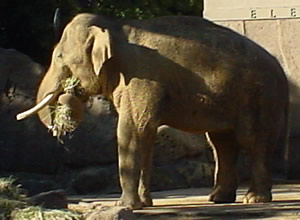
Elephas is one of two surviving genera in the family of elephants, Elephantidae, with one surviving species, the Asian elephant, Elephas maximus.

Homo floresiensis( also known as "Flores Man") is an extinct species of small archaic human that inhabited the island of Flores, Indonesia, until the arrival of modern humans about 50,000 years ago.

Stegodon is an extinct genus of proboscidean, related to elephants. It was originally assigned to the family Elephantidae along with modern elephants but is now placed in the extinct family Stegodontidae. Like elephants, Stegodon had teeth with plate-like lophs that are different from those of more primitive proboscideans like gomphotheres and mammutids. The oldest fossils of the genus are found in Late Miocene strata in Asia, likely originating from the more archaic Stegolophodon, shortly afterwards migrating into Africa. While the genus became extinct in Africa during the Pliocene, Stegodon remained widespread in South, Southeast and East Asia until the end of the Pleistocene.

Dwarf elephants are prehistoric members of the order Proboscidea which, through the process of allopatric speciation on islands, evolved much smaller body sizes in comparison with their immediate ancestors. Dwarf elephants are an example of insular dwarfism, the phenomenon whereby large terrestrial vertebrates that colonize islands evolve dwarf forms, a phenomenon attributed to adaptation to resource-poor environments and lack of predation and competition. Some modern populations of Asian elephants have also undergone size reduction on islands to a lesser degree, resulting in populations of pygmy elephants.

Liang Bua is a limestone cave on the island of Flores, Indonesia, slightly north of the town of Ruteng in Manggarai Regency, East Nusa Tenggara. The cave demonstrated archaeological and paleontological potential in the 1950s and 1960s as described by the Dutch missionary and archaeologist Theodor L. Verhoeven.

Palaeoloxodon recki is an extinct species of elephant native to Africa and likely West Asia from the late Pliocene to Middle Pleistocene. During most of its existence, it represented the dominant elephant species in East Africa.

Sinomastodon is an extinct gomphothere genus known from the Late Miocene to Early Pleistocene of Asia, including China, Japan, Thailand, Myanmar, Indonesia and probably Kashmir.
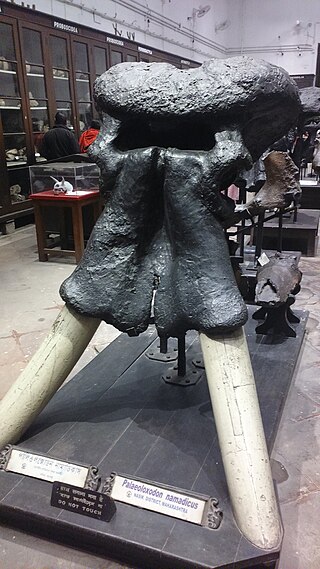
Palaeoloxodon namadicus is an extinct species of prehistoric elephant known from the early Middle to Late Pleistocene of the Indian subcontinent, and possibly also elsewhere in Asia. The species grew larger than any living elephant, and some authors have suggested it to have been the largest known land mammal, based on extrapolation from fragmentary remains, though these estimates are speculative.

Elephas hysudricus is an extinct elephant species known from the Pleistocene of Asia. It is thought to be ancestral to the living Asian elephant, from which it is distinguished by the molar teeth having a lower crown height and a lower lamellae number. Remains of the species are primarily known from the Indian subcontinent, with the most important remains coming from the Siwalik Hills. The oldest remains of the species in the Siwaliks are placed at around 2.6 million year ago at the beginning of the Early Pleistocene, with the youngest dates in the Siwaliks during the Middle Pleistocene around 0.6 million years ago, though it likely persisted on the subcontinent later than this based on remains found elsewhere. Remains likely attributable to the species are also known from the Levant in Israel and Jordan, dating to the late Middle Pleistocene, likely sometime between 500-100,000 years ago. Isotopic analysis of specimens from the Indian subcontinent suggests that early members of the species were likely primarily grazers, but shifted towards mixed feeding after the arrival of the substantially larger elephant species Palaeoloxodon namadicus to the region. It is suggested to be closely related and possibly ancestral to the extinct Elephas hysudrindicus from the Pleistocene of Java in Indonesia.

Stegodon aurorae, also known as the Akebono elephant, is a species of fossil elephantoid known from Early Pleistocene Japan and Taiwan.
Panthera tigris soloensis, known as the Ngandong tiger, is an extinct subspecies of the modern tiger species. It inhabited the Sundaland region of Indonesia during the Pleistocene epoch.
Mata Menge is an early Middle Pleistocene paleoanthropological site located in the Ola Bula Formation in the So'a Basin on the island of Flores, Indonesia. Lithic artefacts and hominin remains have been discovered at the site. The level of sophistication of the Mata Menge lithic artefacts is described as being 'simple'.

The region of Southeast Asia is considered a possible place for the evidence of archaic human remains that could be found due to the pathway between Australia and mainland Southeast Asia, where the migration of multiple early humans has occurred out of Africa. One of many pieces of evidence is of the early human found in central Java of Indonesia in the late 19th century by Eugene Dubois, and later in 1937 at Sangiran site by G.H.R. van Koenigswald. These skull and fossil materials are Homo erectus, named Pithecanthropus erectus by Dubois and Meganthropus palaeojavanicus by van Koenigswald. They were dated to c. 1.88 and 1.66 Ma, as suggested by Swisher et al. by analysis of volcanic rocks.
Mececyon trinilensis, the Trinil dog, is an extinct canid species that lived on the island of Java in Indonesia during the Pleistocene.
Varanus hooijeri is an extinct species of medium-sized monitor lizard found in Liang Bua on Flores and possibly also Sumba, dating to the Late Pleistocene and Holocene.

Stegoloxodon is an extinct genus of dwarf elephant known from the Early Pleistocene of Indonesia. It contains two species, S. indonesicus from Java, and S. celebensis from Sulawesi. Its relationship with other elephants is uncertain.

